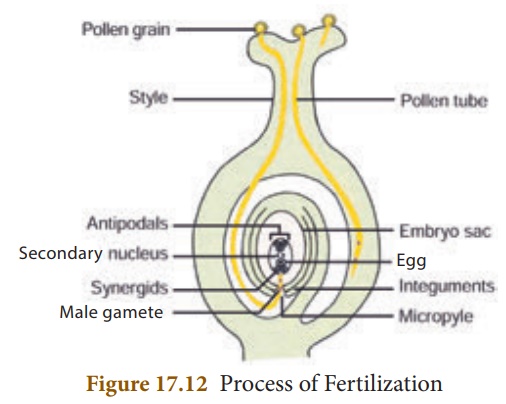Significance | Reproduction in Plants - Fertilization in Plants | 10th Science : Chapter 17 : Reproduction in Plants and Animals
Chapter: 10th Science : Chapter 17 : Reproduction in Plants and Animals
Fertilization in Plants
Fertilization
in Plants

·
Pollen grains reach the right stigma and begin to germinate.
·
Pollen grain forms a small tube-like structure called pollen
tube which emerges through the germ pore. The contents of the pollen grain move
into the tube.
·
Pollen tube grows through the tissues of the stigma and style and
finally reaches the ovule through the micropyle.
·
Vegetative cell degenerates and the generative cell divides
to form two sperms (or male gametes).
·
Tip of pollen tube bursts and the two sperms enter the embryo
sac.
·
One sperm fuses with the egg (syngamy) and forms a diploid
zygote. The other sperm fuses with the secondary nucleus (Triple fusion) to
form the primary endosperm nucleus which is triploid in nature. Since two types
of fusion syngamy and triple fusion take place in an embryo sac the process is
termed as double fertilization.
·
After triple fusion, primary endosperm nucleus develops into an
endosperm.
·
Endosperm provides food to the developing embryo.
·
Later the synergids and antipodal cells degenerate.
Significance of Fertilization
(i) It stimulates the ovary to develop into fruit.
(ii) It helps in development of new characters from two different
individuals.
Post fertilization changes:
1. The ovule develops into a seed.
2. The integuments of the ovule develop into the seed coat.
3. The ovary enlarges and develops into a fruit.
The seed contains the
future plant or embryo which develops into a seedling under appropriate
conditions.
Related Topics